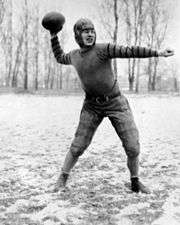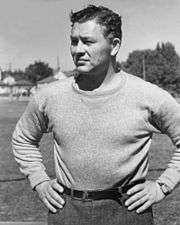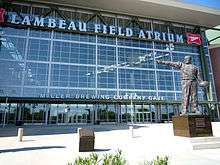Curly Lambeau
|
Lambeau at Notre Dame, 1918 | |
| Position: | Halfback, kicker |
|---|---|
| Personal information | |
| Date of birth: | April 9, 1898 |
| Place of birth: | Green Bay, Wisconsin |
| Date of death: | June 1, 1965 (aged 67) |
| Place of death: | Sturgeon Bay, Wisconsin |
| Career information | |
| High school: | Green Bay (WI) East |
| College: | Notre Dame |
| Career history | |
| As player: | |
| |
| As coach: | |
| |
| Career highlights and awards | |
| |
| Head coaching record | |
| Regular season: | 226–132–22 (.624) |
| Postseason: | 3–2–0 (.600) |
| Career: | 229–134–22 (.623) |
| Player stats at PFR | |
| Coaching stats at PFR | |
Earl Louis "Curly" Lambeau (April 9, 1898 – June 1, 1965) was a professional American football player and coach in the National Football League (NFL). Lambeau was a founder, player, and first coach of the Green Bay Packers professional football team. He shares the distinction with rival George Halas of the Chicago Bears of coaching his team to the most NFL championships, with six. He was an inaugural inductee to the Pro Football Hall of Fame in 1963.
Early life
Lambeau was born April 9, 1898 in Green Bay, Wisconsin, to Marcelin Lambeau and Mary Sara La Tour, both of Belgian ancestry.
Lambeau was a standout multi-sport athlete at Green Bay East High School, and captain of its football team as a senior in 1917. Lambeau enrolled at the University of Wisconsin but then subsequently quit after freshmen football was cancelled that year. He then attended University of Notre Dame in 1918 and played for legendary coach Knute Rockne, making the Irish's varsity squad as a freshman, but a severe case of tonsillitis forced him to return home before his sophomore year.[1]
Professional football
Founding the Packers

After returning to Green Bay, Lambeau went to work as a shipping clerk at the Indian Packing Company. Lambeau and George Whitney Calhoun founded the Green Bay Packers on August 11, 1919, after the packing company put up $500 for uniforms. The team's name reportedly was offered to Curly by his girlfriend Agnes Aylward after a pickup game; Curly had wanted to call the team "The Green Bay Indians" to respect Indian Packing's purchase of uniforms for the team; so Agnes simply blurted, "Well, for heaven's sake, Curly, why don't you just call them the Green Bay Packers!" The team's naming rights were sold to the Acme Packing Company, and the team remained Packers.[2]
The Packers initially played teams from Wisconsin and Michigan's Upper Peninsula. However, the success of the team in 1919-20 quickly led to its joining of the American Professional Football Association (now called the National Football League) in 1921.[2] During that season the team was owned by the Acme Packing Company and John and Emmet Clair of Chicago.
Green Bay Packers

Lambeau was the head coach of the Packers from 1919 to 1949, 1921 and after in the NFL. For the better part of that time, he had almost complete control over the team's day-to-day operations.
Lambeau was a player-coach at first. Playing halfback in the then-popular single wing offensive formation, he was both the primary runner and passer. Lambeau threw 24 touchdown passes, rushed for eight touchdowns, and caught three touchdowns in 77 games. Lambeau was the first Packer to throw a pass, throw a touchdown pass, and make a field goal in Green Bay Packer franchise history.[1] He won his only National Football League championship as a player-coach in 1929, thereafter coaching only. In 1921, he was the team's kicker. He also kicked 1 field goal each in 1922, 1924, and 1925.[3]
Before joining the NFL, the Packers achieved an overall 19–2–1 record in 1919 and 1920.[1] Under Lambeau in the NFL, the Packers won six championships (1929, 1930, 1931, 1936, 1939, 1944). He compiled an NFL regular-season record of 209–104–21 (.657) with a playoff record of 3–2, 212–106–21 (.656) overall. Lambeau is still far and away the winningest coach in Packers history; his 209 wins are more than double those of runner-up Mike McCarthy, who is the current coach of the team. His 104 losses will likely never be matched as well.
The Packers' most successful period came in the 1930s, thanks to the addition of receiver Don Hutson, one of the best receivers in the history of the NFL. Lambeau and Hutson pioneered the passing game, which allowed the Packers to dominate their competitors throughout the 1930s.[2]
End of the Lambeau era in Green Bay
In 1946, Lambeau purchased Rockwood Lodge, a former Norbertine retreat, creating the first self-contained training facility in professional football. The purchase was controversial among the Packers' board of directors, many of whom balked at the $32,000 purchase price and $8,000 spent on renovations. Two of the directors nearly resigned. Lambeau's players grew to hate the facility as well, partly because they were severely battered by the brick-hard limestone under the fields.[4]
In addition, the Packers had begun noticeably slipping on the field after Hutson's retirement in 1945. Still, the Packers remained competitive until 1948, when they suffered their first losing season since 1933, and only the second losing season in franchise history. The bottom fell out in 1949, when the Packers won only two games—at the time, their worst season ever.
The Packers were also suffering financially, mainly due to the Rockwood Lodge purchase. Early in the 1949 season, Lambeau largely turned over control of the team to his assistants to devote his attention to the team's financial situation. Even reducing the payroll and his own salary were not enough to staunch the bleeding. By the end of the season, the Packers were on what seemed to be an irreversible slide toward bankruptcy. Desperate for cash, Lambeau found investors willing to pump money into the team if it abolished its then-unique public ownership structure. This proposal was considered rank heresy in Green Bay, and led to rumors that the NFL was pressuring Lambeau to move the team. Team officials responded by offering him a revised contract that stripped him of nearly all control over non-football matters. Lambeau rejected this offer almost out of hand. For all intents and purposes, this was the end of his 31-year tenure at the helm of the team he founded. However, he didn't formally resign until February 1, 1950,[5][6] seven days after his beloved Rockwood Lodge burned down in a fire that remains unsolved to this day. The insurance money relieved the Packers' financial woes at one stroke, and ensured they would stay in Green Bay.[4]
After Green Bay
Lambeau coached the Chicago Cardinals in 1950 and 1951 and the Washington Redskins in 1952 and 1953 but was nowhere near as successful as he had been in Green Bay, winning only 12 games total in these four seasons. In August 1954, Lambeau got into a heated argument with Redskins owner George Preston Marshall in the lobby of Sacramento's Senator Hotel and was promptly fired.[7][8][9]
Lambeau completed his 33-year NFL coaching career with an official overall record of 229–134–22 (.623).
Personal life
Lambeau was married three times: first to Marguerite Van Kessel from 1919 to 1934, ending in divorce with one son. His second wife, Susan Johnson, was a former Miss California and they were married from 1935 to 1940. He married Grace Garland in 1945 and was divorced in 1955.
Lambeau died at age 67 of a heart attack in Wisconsin, while mowing the lawn at his girlfriend's residence in Sturgeon Bay in June 1965.[10][11]
Legacy

The Packers' home stadium, Lambeau Field, was named after him. The venue opened in 1957 as the second City Stadium, and was informally called "New" City Stadium for its first eight years.[12] It was renamed in August 1965,[13][14] two months after Lambeau's death. The Packers then won three consecutive league titles, which has yet to be repeated.
Erected after the stadium's 2003 renovation, a 14-foot (4.3 m) statue of Lambeau greets visitors.
Lambeau Street, in Green Bay's Packerland Industrial Park, is also named in his honor.
Among other things, Lambeau is credited with pioneering daily practices, the forward pass in the NFL, implementing pass patterns and flying to road games.[1]
Lambeau was elected to the Wisconsin Athletic Hall of Fame in 1961.
Lambeau was inducted into the Pro Football Hall of Fame's inaugural class in 1963.
See also
- List of National Football League head coaches with 50 wins
- List of professional gridiron football coaches with 200 wins
References
- 1 2 3 4 "Hall of Famers: Earl L. (Curly) Lambeau — Class of 1963". Retrieved 2013-04-04.
- 1 2 3 The Legend of Lambeau Field DVD
- ↑ http://www.pro-football-reference.com/players/L/LambCu20.htm
- 1 2 Fleming, David (September 19, 2013). "Blaze of Glory". ESPN The Magazine. Retrieved March 21, 2014.
- ↑ "Curly Lambeau quits to coach the Cardinals". Milwaukee Journal. February 1, 1950. p. 1, part 1.
- ↑ "Lambeau quits for Card job; Isbell seeks Packer post". Milwaukee Sentinel. Associated Press. February 2, 1950. p. 5, part 2.
- ↑ "Lambeau fired as Skins coach". Daytona Beach Morning Journal. Associated Press. August 1954. p. 6.
- ↑ "Lambeau dismissed as Redskins coach". Milwaukee Journal. Associated Press. August 23, 1954. p. 9, part 2.
- ↑ Don Bosley (March 5, 2000). "Sacramento's Big 10: This Summer's U.S. Olympic Track And Field Trials Figures To Make Major News, But The City's History Is Filled With Momentous Sports Happenings. Here Is A List Of The Ones Our Panel Thought Mattered Most...". Sacramento Bee. p. C1.
|section=ignored (help) - ↑ "Curly Lambeau is Stricken and Dies of a Heart Attack". Lawrence (Kansas) Daily Journal World. Associated Press. June 2, 1965. p. 18. Retrieved 2013-04-04.
- ↑ "Lambeau, Packer founder, dies; led club to 6 pro league titles". Milwaukee Journal. June 2, 1965. p. 19.
- ↑ "Crowd of 32,132 fills Green Bay's new City Stadium, sees Packers upset Bears". Milwaukee Journal. September 30, 1957. p. 7-part 2.
- ↑ "Packer board backs Lambeau Field idea". Milwaukee Journal. UPI. August 3, 1965. p. 18-part 2.
- ↑ "'Lambeau Field' voted by council". Milwaukee Sentinel. Associated Press. August 5, 1965. p. 3-part 2.
- "Green Bay Packers Coaches - Curly Lambeau". Packers.com. Retrieved 2008-03-22.
- "Green Bay Packers History - Birth of a Team and a Legend". Packers.com. Retrieved 2008-03-22.
- "Member - Pro Football Hall of Fame - Curly Lambeau". Profootballhof.com. Retrieved 2008-03-22.
External links
- Curly Lambeau at the Pro Football Hall of Fame
- Career statistics and player information from Pro-Football-Reference • Databasefootball.com
- Curly Lambeau at Find a Grave
